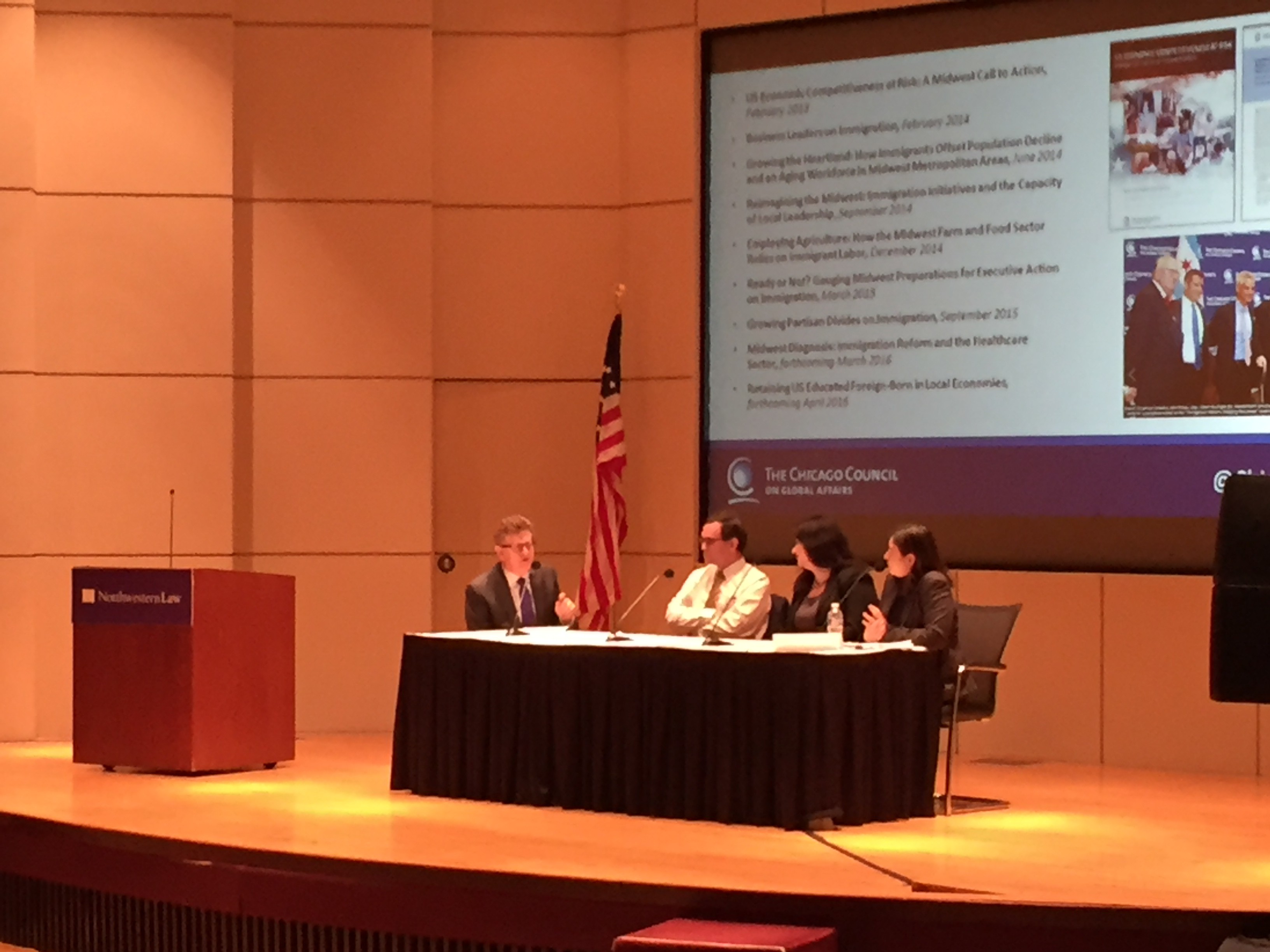By Hannah Rank
Leaders in immigration research argued Friday that immigration has significant economic and demographic benefits for the city of Chicago.
“What I’m seeing from my clients is that they are contributing to society regardless of what their immigration status is,” said Olga Rojas, chair of the Chicago chapter of the American Immigration Lawyers. Rojas added that more than 40 percent of immigrants in Illinois are naturalized.
Speakers for the panel discussing the political, social and economic implications of immigration for Chicago included Rojas, Rob Paral, a demographer and policy specialist based in Chicago, and Juliana Kerr, a researcher from the Chicago Council on Global Affairs. They spoke during a symposium titled “Immigration Conundrum,” held Thursday and Friday at Northwestern University Pritzker School of Law and hosted by the 7th Circuit Bar Association Foundation. The conference brought together lawyers and judges working in the immigration courts, as well as policy and economic influencers from across the country.
Speaking specifically about the demographic implications of immigration, Paral noted that Mexican immigrants offset Chicago’s population loss during the 1990s. During that decade, the city’s population grew by 112,000 people: The native-born population fell by 47,000 as foreign-born rose by 160,000, with 117,000 being Mexican.
“No other city has depended on Mexican immigration to sustain its population like Chicago has,” Paral said.

Rojas and Kerr focused on the economic potential for a strong immigrant labor force in the Chicago region.
Yet in Kerr’s research on the global competitiveness of Chicago’s business community, she noted the persistent problem of retaining the pool of eligible foreign-born candidates in the labor market. She described a striking visit she had to Argonne National Laboratory, based in Lemont, southwest of Chicago.
“We had gone out there to do a conversation about energy policy, about global cities, about advancements in technology, and I walked in with all our material on our competitiveness and I ended up speaking about immigration the entire time,” Kerr said. “Seventy percent of their scientists are post-docs from around the world.
“A lot of leaders in Chicago – business leaders, presidents of universities, presidents of hospital systems,” Kerr continued, “started talking about their own need for immigration law reform to be able to maintain competitiveness, maintain their industries, in today’s world.”
Rojas noted the high number of foreign-born students educated in the U.S. also contribute to local economies in Illinois.
“Foreign students are very necessary for the universities,” Rojas said. She said that in the 2013-2014 academic year, more than 42,000 foreign-born students in Illinois’ colleges and universities contribute economically by paying room and board and full tuition, among other expenses.
Rojas also argued foreign-born students contribute to innovation. She said nationally, a large portion of the master’s and doctorate degrees go to non-resident aliens. She noted that 90 percent of the patents developed in the University of Illinois systems had at least one foreign-born inventor.
Kerr noted the difficulty for foreign-born students to stay in the country upon graduation means oftentimes that educational investment is being exported to other globally-competing countries.
“We curate all these stories of the PhD chemist who had a brilliant idea who’s trying to launch his company,” Kerr said. “He’s got the venture capital funding and he has the employees to launch it, he just doesn’t have a legal way to stay here and operate his business.”
Kerr explained after the panel that her organization will be releasing a report in April that lays out recommendations for retaining this qualified labor force. The recommendations will include extending the post-graduate time for foreign-born job seekers to stay in the country and also developing start-up visas for valuable entrepreneurs.
Another economic contribution the panelists touched on was the tax base of undocumented immigrants.
“Many seem to forget everyone pays taxes regardless of your immigration status,” Rojas said, noting in 2013 undocumented immigrants paid nearly $750 million in state and local taxes in Illinois.
This is particularly relevant in Chicago where the majority of Mexican immigrants, and especially those arriving during the 1990s, are undocumented and getting older, according to a recent analysis by Paral. In it, Paral points out that they may be in their “prime tax-paying years.”
Paral cautions that the population booms to Chicago from Mexican immigration have slowed, with a dramatic demographic shift since 2000, after which Chicago’s overall population began to fall. That was due to a continuing decline in native-born population, and also a drop in the flow of immigrants – specifically Mexican immigrants – into the city and into the U.S. Between 2009 and 2014, more Mexicans left than entered the United States.
A look at the city’s Lawndale community southwest of the Loop provides stark evidence of the trend, Paral said. The community of 60,000 people is 50 percent foreign born – 85 percent Latino- and it lost 10 percent of its population between 2000 and 2010.
In a separate panel held Thursday afternoon discussing the economic impact of immigration across the U.S. generally, Pia Orrenius from the Federal Reserve Bank of Dallas spoke on the possible implications on the immigrant tax base if states were to mandate E-Verify, an online system where business track the “eligibility” of their employers.
Orrenius noted that most undocumented immigrants work “on the books,” meaning they are pay taxes from their paychecks each month.
“Interior enforcement [of E-Verify] is breaking this system down,” Orrenius said. “This will have adverse outcomes for immigrant families,” she added, noting they will be pushed into unregulated “shadow economies” working in worsened conditions.


